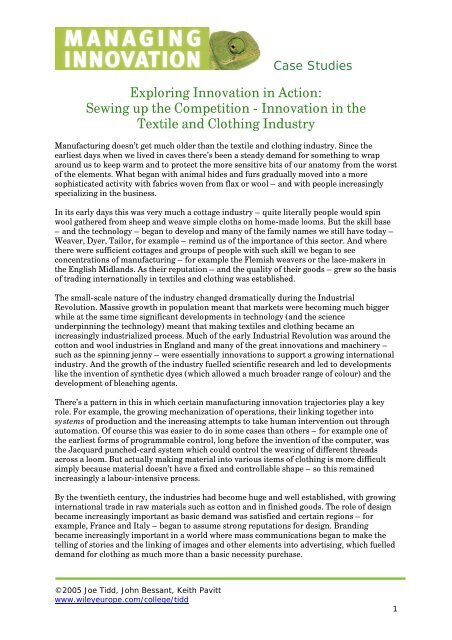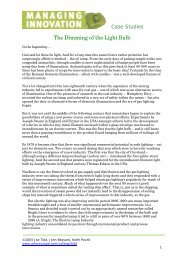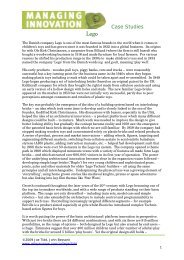Exploring Innovation in Action: Sewing up the Competition ...
Exploring Innovation in Action: Sewing up the Competition ...
Exploring Innovation in Action: Sewing up the Competition ...
You also want an ePaper? Increase the reach of your titles
YUMPU automatically turns print PDFs into web optimized ePapers that Google loves.
©2005 Joe Tidd, John Bessant, Keith Pavitt<br />
www.wileyeurope.com/college/tidd<br />
Case Studies<br />
<strong>Explor<strong>in</strong>g</strong> <strong>Innovation</strong> <strong>in</strong> <strong>Action</strong>:<br />
Sew<strong>in</strong>g <strong>up</strong> <strong>the</strong> <strong>Competition</strong> - <strong>Innovation</strong> <strong>in</strong> <strong>the</strong><br />
Textile and Cloth<strong>in</strong>g Industry<br />
Manufactur<strong>in</strong>g doesn’t get much older than <strong>the</strong> textile and cloth<strong>in</strong>g <strong>in</strong>dustry. S<strong>in</strong>ce <strong>the</strong><br />
earliest days when we lived <strong>in</strong> caves <strong>the</strong>re’s been a steady demand for someth<strong>in</strong>g to wrap<br />
around us to keep warm and to protect <strong>the</strong> more sensitive bits of our anatomy from <strong>the</strong> worst<br />
of <strong>the</strong> elements. What began with animal hides and furs gradually moved <strong>in</strong>to a more<br />
sophisticated activity with fabrics woven from flax or wool – and with people <strong>in</strong>creas<strong>in</strong>gly<br />
specializ<strong>in</strong>g <strong>in</strong> <strong>the</strong> bus<strong>in</strong>ess.<br />
In its early days this was very much a cottage <strong>in</strong>dustry – quite literally people would sp<strong>in</strong><br />
wool ga<strong>the</strong>red from sheep and weave simple cloths on home-made looms. But <strong>the</strong> skill base<br />
– and <strong>the</strong> technology – began to develop and many of <strong>the</strong> family names we still have today –<br />
Weaver, Dyer, Tailor, for example – rem<strong>in</strong>d us of <strong>the</strong> importance of this sector. And where<br />
<strong>the</strong>re were sufficient cottages and gro<strong>up</strong>s of people with such skill we began to see<br />
concentrations of manufactur<strong>in</strong>g – for example <strong>the</strong> Flemish weavers or <strong>the</strong> lace-makers <strong>in</strong><br />
<strong>the</strong> English Midlands. As <strong>the</strong>ir reputation – and <strong>the</strong> quality of <strong>the</strong>ir goods – grew so <strong>the</strong> basis<br />
of trad<strong>in</strong>g <strong>in</strong>ternationally <strong>in</strong> textiles and cloth<strong>in</strong>g was established.<br />
The small-scale nature of <strong>the</strong> <strong>in</strong>dustry changed dramatically dur<strong>in</strong>g <strong>the</strong> Industrial<br />
Revolution. Massive growth <strong>in</strong> population meant that markets were becom<strong>in</strong>g much bigger<br />
while at <strong>the</strong> same time significant developments <strong>in</strong> technology (and <strong>the</strong> science<br />
underp<strong>in</strong>n<strong>in</strong>g <strong>the</strong> technology) meant that mak<strong>in</strong>g textiles and cloth<strong>in</strong>g became an<br />
<strong>in</strong>creas<strong>in</strong>gly <strong>in</strong>dustrialized process. Much of <strong>the</strong> early Industrial Revolution was around <strong>the</strong><br />
cotton and wool <strong>in</strong>dustries <strong>in</strong> England and many of <strong>the</strong> great <strong>in</strong>novations and mach<strong>in</strong>ery –<br />
such as <strong>the</strong> sp<strong>in</strong>n<strong>in</strong>g jenny – were essentially <strong>in</strong>novations to s<strong>up</strong>port a grow<strong>in</strong>g <strong>in</strong>ternational<br />
<strong>in</strong>dustry. And <strong>the</strong> growth of <strong>the</strong> <strong>in</strong>dustry fuelled scientific research and led to developments<br />
like <strong>the</strong> <strong>in</strong>vention of syn<strong>the</strong>tic dyes (which allowed a much broader range of colour) and <strong>the</strong><br />
development of bleach<strong>in</strong>g agents.<br />
There’s a pattern <strong>in</strong> this <strong>in</strong> which certa<strong>in</strong> manufactur<strong>in</strong>g <strong>in</strong>novation trajectories play a key<br />
role. For example, <strong>the</strong> grow<strong>in</strong>g mechanization of operations, <strong>the</strong>ir l<strong>in</strong>k<strong>in</strong>g toge<strong>the</strong>r <strong>in</strong>to<br />
systems of production and <strong>the</strong> <strong>in</strong>creas<strong>in</strong>g attempts to take human <strong>in</strong>tervention out through<br />
automation. Of course this was easier to do <strong>in</strong> some cases than o<strong>the</strong>rs – for example one of<br />
<strong>the</strong> earliest forms of programmable control, long before <strong>the</strong> <strong>in</strong>vention of <strong>the</strong> computer, was<br />
<strong>the</strong> Jacquard punched-card system which could control <strong>the</strong> weav<strong>in</strong>g of different threads<br />
across a loom. But actually mak<strong>in</strong>g material <strong>in</strong>to various items of cloth<strong>in</strong>g is more difficult<br />
simply because material doesn’t have a fixed and controllable shape – so this rema<strong>in</strong>ed<br />
<strong>in</strong>creas<strong>in</strong>gly a labour-<strong>in</strong>tensive process.<br />
By <strong>the</strong> twentieth century, <strong>the</strong> <strong>in</strong>dustries had become huge and well established, with grow<strong>in</strong>g<br />
<strong>in</strong>ternational trade <strong>in</strong> raw materials such as cotton and <strong>in</strong> f<strong>in</strong>ished goods. The role of design<br />
became <strong>in</strong>creas<strong>in</strong>gly important as basic demand was satisfied and certa<strong>in</strong> regions – for<br />
example, France and Italy – began to assume strong reputations for design. Brand<strong>in</strong>g<br />
became <strong>in</strong>creas<strong>in</strong>gly important <strong>in</strong> a world where mass communications began to make <strong>the</strong><br />
tell<strong>in</strong>g of stories and <strong>the</strong> l<strong>in</strong>k<strong>in</strong>g of images and o<strong>the</strong>r elements <strong>in</strong>to advertis<strong>in</strong>g, which fuelled<br />
demand for cloth<strong>in</strong>g as much more than a basic necessity purchase.<br />
1
©2005 Joe Tidd, John Bessant, Keith Pavitt<br />
www.wileyeurope.com/college/tidd<br />
Case Studies<br />
Mass production methods and <strong>the</strong> scientific management approaches underp<strong>in</strong>n<strong>in</strong>g <strong>the</strong>m<br />
diffused rapidly and, <strong>in</strong> <strong>the</strong> case of cloth<strong>in</strong>g assembly which rema<strong>in</strong>ed a labour-<strong>in</strong>tensive<br />
process, led to <strong>the</strong> quest for lower-wage-cost locations. So began <strong>the</strong> migration of cloth<strong>in</strong>g<br />
manufacture around <strong>the</strong> world, visit<strong>in</strong>g and settl<strong>in</strong>g <strong>in</strong> ever cheaper locations across <strong>the</strong> Far<br />
East, through much of Africa and Lat<strong>in</strong> America to its present home <strong>in</strong> Ch<strong>in</strong>a.<br />
Today this is a global <strong>in</strong>dustry embrac<strong>in</strong>g design activities, cutt<strong>in</strong>g and process<strong>in</strong>g<br />
operations, assembly, distribution and sales – all fuelled by a huge demand for<br />
differentiation and personalization. This is an <strong>in</strong>dustry <strong>in</strong> which price is only one element –<br />
non-price factors such as variety, speed, brand and quality matter. And it’s an <strong>in</strong>dustry<br />
dom<strong>in</strong>ated by <strong>the</strong> need for high-frequency product <strong>in</strong>novation – fashion collections no<br />
longer run along <strong>the</strong> old seasonal track with w<strong>in</strong>ter and summer collections. In some cases<br />
<strong>the</strong> range is changed every month and <strong>in</strong>novation <strong>in</strong> <strong>in</strong>formation and communications<br />
technology means that this cycle is gett<strong>in</strong>g shorter still.<br />
All of this has shaped an <strong>in</strong>dustry which is highly networked across global ‘value cha<strong>in</strong>s’ and<br />
coord<strong>in</strong>ated by a few major players. Much of <strong>the</strong> ‘front’ end of <strong>the</strong> <strong>in</strong>dustry is about major<br />
brands and retail cha<strong>in</strong>s while <strong>the</strong> ‘backroom’ operations are often small-scale<br />
subcontractors often <strong>in</strong> low-wage-cost areas of <strong>the</strong> world.<br />
Like so many <strong>in</strong>dustries it has become somewhat footloose and wandered from its orig<strong>in</strong>s –<br />
leav<strong>in</strong>g beh<strong>in</strong>d only a small rem<strong>in</strong>der of its orig<strong>in</strong>al dom<strong>in</strong>ance. Compared with countries<br />
like India and Ch<strong>in</strong>a today’s European cloth<strong>in</strong>g <strong>in</strong>dustry is a small player on <strong>the</strong> global stage.<br />
There are some exceptions to this – and <strong>the</strong>y underl<strong>in</strong>e <strong>the</strong> power of <strong>in</strong>novation and<br />
entrepreneurship.<br />
Just because <strong>the</strong> dom<strong>in</strong>ant trends lead <strong>in</strong> one direction doesn’t mean that <strong>the</strong>re isn’t scope<br />
for someone to spot and deploy ways of buck<strong>in</strong>g this trend. One such player was a young<br />
clerk work<strong>in</strong>g <strong>in</strong> a small cloth<strong>in</strong>g retail<strong>in</strong>g bus<strong>in</strong>ess <strong>in</strong> nor<strong>the</strong>rn Spa<strong>in</strong>. Frustrated with his<br />
career prospects Amancio Ortega Gaona decided to strike out on his own and <strong>in</strong> 1963<br />
<strong>in</strong>vested his sav<strong>in</strong>gs – <strong>the</strong> pr<strong>in</strong>cely sum of US$25 – <strong>in</strong>to a small manufactur<strong>in</strong>g operation<br />
mak<strong>in</strong>g pyjamas and l<strong>in</strong>gerie. In classic fashion he peddled (and pedalled – his earliest<br />
transport was a bicycle!) his wares around <strong>the</strong> region and built <strong>the</strong> bus<strong>in</strong>ess over <strong>the</strong> next 10<br />
years and <strong>the</strong>n decided to move <strong>in</strong>to retail<strong>in</strong>g as well, open<strong>in</strong>g his first shop <strong>in</strong> <strong>the</strong> northwestern<br />
town of La Coruna <strong>in</strong> 1975.<br />
Th<strong>in</strong>gs have moved on somewhat s<strong>in</strong>ce <strong>the</strong>n. Industria de Diseno Textil – Inditex – <strong>the</strong><br />
hold<strong>in</strong>g company which he established – is now worth around US$8 billion and has just<br />
opened its two-thousandth store <strong>in</strong> Hong Kong. Active <strong>in</strong> nearly 70 countries this textile and<br />
cloth<strong>in</strong>g bus<strong>in</strong>ess has 8 key brand gro<strong>up</strong>s, each targeted at particular segments or product<br />
types – for example, ‘Pull and Bear’ for children, ‘Massimo Dutti’ for older men and women<br />
or ‘Oysho’ <strong>in</strong> l<strong>in</strong>gerie. Best known of <strong>the</strong>se is ‘Zara’ – a global brand with strong design and<br />
fashion identity runn<strong>in</strong>g through both <strong>the</strong> clo<strong>the</strong>s and <strong>the</strong> stores <strong>in</strong> which <strong>the</strong>y are sold.<br />
Its clo<strong>the</strong>s comb<strong>in</strong>e stylish designs with a strong l<strong>in</strong>k to current high fashion <strong>the</strong>mes with<br />
moderate prices. As Lotte Freddie, fashion editor of <strong>the</strong> Danish daily newspaper Berl<strong>in</strong>gske<br />
Tidende, commented, ‘If you want a classic, Italianate look <strong>in</strong> tune with current styles and at<br />
a reasonable price go to Zara.’ Zara’s successful growth is not simply a matter of low cost or<br />
of standardization but ra<strong>the</strong>r of <strong>in</strong>novation.<br />
The company have become leaders by exploit<strong>in</strong>g some of <strong>the</strong> key non-price trends <strong>in</strong> <strong>the</strong><br />
<strong>in</strong>dustry – for example, variety and product <strong>in</strong>novation. For example, over 10 000 different<br />
2
©2005 Joe Tidd, John Bessant, Keith Pavitt<br />
www.wileyeurope.com/college/tidd<br />
Case Studies<br />
cloth<strong>in</strong>g models are created and sold every year – this is most certa<strong>in</strong>ly not a case of ‘one size<br />
fits all’ or of long-last<strong>in</strong>g product types! Ortega has taken <strong>the</strong> entire system for creat<strong>in</strong>g<br />
clo<strong>the</strong>s and built a bus<strong>in</strong>ess – and orig<strong>in</strong>ally did so <strong>in</strong> an area which did not previously have<br />
any textile tradition.<br />
At an early stage <strong>in</strong> <strong>the</strong> development of <strong>the</strong> manufactur<strong>in</strong>g bus<strong>in</strong>ess he moved back <strong>in</strong>to<br />
textile-f<strong>in</strong>ish<strong>in</strong>g operations to make sure that <strong>the</strong> colours and quality of <strong>the</strong> material he used<br />
to make <strong>the</strong> clo<strong>the</strong>s were <strong>up</strong> to scratch. Not only did this give better quality control but it also<br />
opened <strong>up</strong> <strong>the</strong> road to offer<strong>in</strong>g excit<strong>in</strong>g and different fabric designs and textures. There are<br />
now 18 textile-design<strong>in</strong>g and -f<strong>in</strong>ish<strong>in</strong>g operations <strong>in</strong> <strong>the</strong> gro<strong>up</strong> as well as <strong>the</strong> cloth<strong>in</strong>g<br />
manufactur<strong>in</strong>g.<br />
A major part of <strong>the</strong> company’s success comes from a strong commitment to design – <strong>the</strong>y<br />
employ over 200 designers and make extensive play of this commitment. It’s a <strong>the</strong>me which<br />
doesn’t stop with <strong>the</strong> clo<strong>the</strong>s <strong>the</strong>mselves but also extends to <strong>the</strong> presentation of <strong>the</strong> stores,<br />
<strong>the</strong>ir w<strong>in</strong>dow displays, <strong>the</strong>ir catalogues, Internet advertis<strong>in</strong>g and so on. Part of <strong>the</strong><br />
headquarters build<strong>in</strong>g <strong>in</strong> Arteixo La Coruna, Spa<strong>in</strong> conta<strong>in</strong>s 25 full-size shop w<strong>in</strong>dows with<br />
display platforms and light<strong>in</strong>g which allow <strong>the</strong> team to see what real store w<strong>in</strong>dows would<br />
look like – not only under normal conditions but also on ra<strong>in</strong>y days, at night and so on.<br />
Ano<strong>the</strong>r key aspect of Zara’s success is <strong>the</strong> flexibility which comes from hav<strong>in</strong>g a very<br />
different model for manufactur<strong>in</strong>g. Around 2500 employees work directly <strong>in</strong> manufactur<strong>in</strong>g<br />
operations – but beh<strong>in</strong>d <strong>the</strong>m is a much larger workforce spread across villages and small<br />
communities <strong>in</strong> Spa<strong>in</strong> and nor<strong>the</strong>rn Portugal.<br />
Once <strong>the</strong> new design has been approved <strong>the</strong> fabric is cut and <strong>the</strong>n distributed to this network<br />
of small workshops – and <strong>the</strong>se represent an outsource capability deliver<strong>in</strong>g a high degree of<br />
flexibility. Pre-cut pieces and easy-to-follow <strong>in</strong>structions are given to workers <strong>in</strong> what is still<br />
largely an <strong>in</strong>formal economy – and <strong>the</strong>ir output <strong>the</strong>n flows back <strong>in</strong>to <strong>the</strong> massive Zara<br />
distribution centre like tributaries to a fast-flow<strong>in</strong>g river. (This is not a small operation – <strong>the</strong><br />
centre has around 200 kilometres of mov<strong>in</strong>g rails on which <strong>the</strong> products flow. Highly<br />
automated and with extensive <strong>in</strong>-l<strong>in</strong>e quality check<strong>in</strong>g, <strong>the</strong> process transfers <strong>the</strong> <strong>in</strong>com<strong>in</strong>g<br />
pieces <strong>in</strong>to production lots which are <strong>the</strong>n allocated to a fleet of trucks for fast shipment,<br />
mostly by air from <strong>the</strong> nearby airport at Santiago de Compostella.)<br />
Needless to say this places significant demands on a highly flexible and <strong>in</strong>novative<br />
coord<strong>in</strong>ation system which Zara have developed <strong>in</strong>-house. In this way <strong>the</strong>y make use of a<br />
model which dates back hundreds of years (<strong>the</strong> idea of <strong>in</strong>dustrial districts and clusters) but<br />
use twenty-first-century technologies to make it work to give <strong>the</strong>m huge flexibility <strong>in</strong> both<br />
<strong>the</strong> volume and variety of <strong>the</strong> th<strong>in</strong>gs <strong>the</strong>y make. Where competitors such as H&M and Gap<br />
have to start plann<strong>in</strong>g and produc<strong>in</strong>g <strong>the</strong>ir new l<strong>in</strong>es three to five months before goods<br />
f<strong>in</strong>ally make it to <strong>the</strong> stores, Zara manages <strong>the</strong> whole process <strong>in</strong> less than three weeks!<br />
Their flexibility is also based on rapid response and extensive use of <strong>in</strong>formation and<br />
communication technologies. At <strong>the</strong> end of <strong>the</strong> day as <strong>the</strong> customers leave <strong>the</strong>ir 950 stores<br />
around <strong>the</strong> world <strong>the</strong> sales staff use wireless handsets to communicate <strong>in</strong>ventory levels to <strong>the</strong><br />
store manager who <strong>the</strong>n transmits this <strong>in</strong>telligence back to Spa<strong>in</strong> as a feed <strong>in</strong>to <strong>the</strong> design<br />
order and distribution system. This gives an <strong>up</strong>-to-<strong>the</strong>- m<strong>in</strong>ute idea of what is sell<strong>in</strong>g – and<br />
what isn’t, so <strong>the</strong> stores can be highly responsive to customer preferences – which colours<br />
‘work’, which <strong>the</strong>mes are popular, which designs aren’t hitt<strong>in</strong>g <strong>the</strong> spot. But it’s not just<br />
follow<strong>in</strong>g <strong>the</strong> market – Zara also push <strong>the</strong> game by mak<strong>in</strong>g sure that no model is kept on sale<br />
for more than four weeks – no matter how well it is sell<strong>in</strong>g. This has a strong impact on <strong>the</strong>ir<br />
3
©2005 Joe Tidd, John Bessant, Keith Pavitt<br />
www.wileyeurope.com/college/tidd<br />
Case Studies<br />
brand – <strong>the</strong>y are seen as very orig<strong>in</strong>al and design-led – but it puts even more pressure on<br />
<strong>the</strong>ir ability to be agile <strong>in</strong> design and manufacture.<br />
Case Study Questions<br />
1. Is <strong>the</strong> Zara model susta<strong>in</strong>able? What would you do to preserve <strong>the</strong>ir edge over <strong>the</strong><br />
next 5–10 years, given that many o<strong>the</strong>r players are now look<strong>in</strong>g to follow <strong>the</strong>ir<br />
example? If you don’t th<strong>in</strong>k it can survive, give your reasons for why you th<strong>in</strong>k <strong>the</strong><br />
model is unsusta<strong>in</strong>able and will fail.<br />
2. You have been hired as a consultant to a small cloth<strong>in</strong>g manufacturer who wants to<br />
emulate <strong>the</strong> success of Zara and Benetton. She wants advice on an <strong>in</strong>novation<br />
strategy which takes <strong>the</strong> key lessons from <strong>the</strong>se successful firms. What would you<br />
offer?<br />
3. Zara Home has just opened us<strong>in</strong>g <strong>the</strong> same basic bus<strong>in</strong>ess model and deploy<strong>in</strong>g <strong>the</strong><br />
same <strong>in</strong>novative approach as <strong>the</strong> rest of <strong>the</strong> bus<strong>in</strong>ess but <strong>in</strong> <strong>the</strong> home goods field. Do<br />
you th<strong>in</strong>k it might succeed and why?<br />
4




